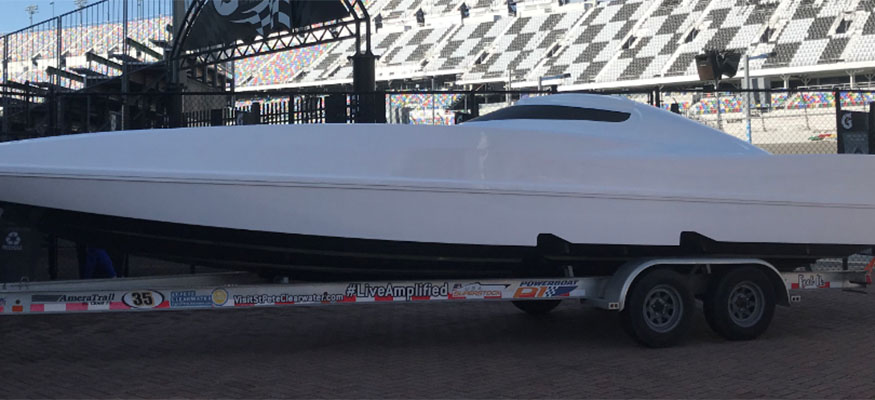Canopied Powerboat P1 SuperStock Prototype Testing Begins This Month
With the start of the 2019 Powerboat P1 SuperStock series just four months away, the race-producing organization is beginning testing of its canopied 29-foot V-bottom protoype powered by a Mercury Racing 300R outboard engine. Powerboat P1, which has offices in the United Kingdom and Orlando, Fla., announced that the 4.6-liter V-8 outboard would become stock power for the 2019 season—and that its carbon-fiber-hull SuperStock raceboats would be built with full canopies—in September 2018.
The SuperStock prototype will be tested in the open Atlantic Ocean as well on a lake in the Orlando area (click image for full frame).
“The principal objectives are to improve the race performance of the boats, enhance safety on the water and attract new racers to the series,” said Azam Rangoonwala, the chief executive officer of Powerboat P1. “The 2019 Panther will look sleek and stylish, but maintain the character of the original deck design. It’s going to be fast and nimble, and will require 100 of the skills each crew brings to the series.”
Wilson Custom Composites, the Fort Pierce, Fla.-based outfit that handle the conversion of SuperStock raceboat hulls to carbon fiber, also will handle the canopy conversion project. Company principal Craig Wilson and his team are working closely with Martin Sanborn—one of the lead developers of the P1 Panther eight years ago—of Performance Boat Center of South Florida.
“The canopy configuration will have a number of important results including enhanced safety for the crews, improved race performance and the change from a mechanical control system to a digital throttle and shift system which will increase responsiveness and simplify the rigging process for the boats,” said Wilson.
The canopy conversion work is complaint with current Union Internationale Motonautique and American Power Boat Association standards, according to Sanborn.
“The canopy and cockpit feature a carbon composite structure that’s both light and exceptionally strong,” he said. “Engineering, that includes a complex integration of a polycarbonate windscreen and receiver together with recessed carbon hatches, is targeted with aerodynamic, hydrodynamic and mechanical impact considerations to provide maximum protection for the racers. On top of the significant weight loss from the hull replacement program a year ago, the boats will see another reduction resulting in a lowering of the vertical center of gravity and better handling.”
Added Wilson, “Powerboat P1 is leap-frogging the marine industry by having the most technically advanced, full safety canopy system and interior available. The DD-compound racing seats are carbon/glass with billet aluminum brackets and stainless steel runners. They are tested to withstand huge G-forces and we fit a six-point harness and full SCUBA system.”
On the power and propulsion side, the team at Mercury Racing is expecting the SuperStock-class competitor to be impressed with the new V-8 outboard, according to Rick Mackie, the Fond du Lac, Wis., company’s public relations and communications manager.
“They will experience a noticeable improvement in acceleration – particularly useful when powering out of turns–together with an increase in top-end speeds,” he said. “Our Mercury propellers will deliver best performance and handling–racing is not all about straight line speed. It’s exciting to have our consumer products used in this highly competitive, one-design racing environment. There is no better way to prove their performance and durability.”
Related stories
Michigan City To Be OPA/Powerboat P1 Event In 2019
OPA and P1 Announce Four Venues For 2019 Championship Series



